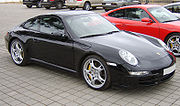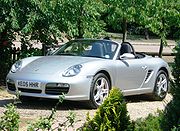From Wikipedia, the free encyclopedia
• Ten things you didn't know about Wikipedia •
Jump to: navigation, search

Lotus Logo with monogram of its founder, Anthony Colin Bruce Chapman
Lotus Cars is a British manufacturer of sports and racing cars based at Hethel, Norfolk, England. The company designs and builds race and production automobiles of light weight and high handling characteristics.
The company is 10 miles (16 km) south-west of Norwich, in East Anglia and was formed as Lotus Engineering Ltd. by the engineer Colin Chapman, in 1952. The first factory was in old stables behind the Railway Hotel in Hornsey. Team Lotus was active and competitive in Formula One racing from 1958 to 1994. Since the 1960s the company has occupied a modern factory and road test facility at Hethel, near Wymondham. This site is the former RAF Hethel base and the test track uses sections of the old runway.
Chapman died of a heart attack in 1982, at the age of 54, having begun life an inn-keeper's son and ended a multi-millionaire industrialist in post-war Britain. The carmaker built tens of thousands of successful racing and road cars and won the Formula One World Championship seven times. At the time of his death he was linked with the DeLorean scandal over the use of government subsidies for the production of the De Lorean DMC-12 for which Lotus had designed the chassis.
In 1986 the company was bought by General Motors. On August 27, 1993, GM sold the company, for £30 million, to A.C.B.N. Holdings S.A. of Luxembourg, a company controlled by Italian businessman Romano Artioli, who also owned Bugatti Automobili SpA. In 1996 a majority share in Lotus was sold to Perusahaan Otomobil Nasional Bhd (Proton), a Malaysian car company listed on the Kuala Lumpur Stock Exchange.
The company also acts as an engineering consultancy, providing engineering development - particularly of suspension - for other car manufacturers. The lesser known Powertrain department is responsible for the design and development of the 4 cylinder engine found in many of GM's Vauxhall, Opel, Saab, and possibly some Saturn cars.
The company is organized as Group Lotus, which is divided into Lotus Cars and Lotus Engineering. Contrary to some rumours, there are no plans to create a Formula One Team. This is more likely to be due to the massive financial input required over and above any of the company's wishes.
Mr. Michael J Kimberley ("Mike"), took over as Acting Chief Executive Officer of the Company and its Group from May 2006. Mike currently chairs the Executive Committee of Lotus Group International Limited ("LGIL") established in February 2006, with Syed Zainal Abidin (Managing Director of Proton Holdings Berhad) and Badrul Feisal (non-executive director of Proton Holdings Berhad). LGIL is the holding company of Lotus Group Plc.

[edit] Formula One
Main article: Team Lotus
Artist's depiction of a Lotus 56 in the pits at Indy
Lotus 77
The company encouraged its customers to race its cars, and itself entered Formula One as a team in 1958. A Lotus Formula One car driven by Stirling Moss won the marque's first Grand Prix in 1960 at Monaco. Major success came in 1963 with the Lotus 25, which — with Jim Clark driving — won Lotus its first F1 World Constructors Championship. Clark's untimely death — he crashed a Formula Two Lotus 48 in April 1968 after his rear tyre failed in a turn in Hockenheim — was a severe blow to the team and to Formula One. He was the dominant driver in the dominant car and remains an inseparable part of Lotus' early years. That year's championship was won by Clark's teammate, Graham Hill.
Lotus is credited with making the mid-engined layout popular for Indycars, developing the first monocoque Formula 1 chassis, and the integration of the engine and transaxle as chassis components. Lotus was also among the pioneers of adding wings to Formula 1 cars to create downforce, as well as the first to move radiators to the sides in F1 cars to aid in aerodynamic performance, and inventing active suspension.
Even after Chapman's death, until the late 1980s, Lotus continued to be a major player in Formula 1. Ayrton Senna drove for the team from 1985 to 1987, winning twice in each year and achieving 17 pole positions. However, by the company's last Formula 1 race in 1994, the cars were no longer competitive. Lotus won a total of 79 Grand Prix races. During his lifetime Chapman saw Lotus beat Ferrari as the first team to achieve 50 Grand Prix victories, despite Ferrari having won their first nine years sooner.

• Ten things you didn't know about Wikipedia •
Jump to: navigation, search

Lotus Logo with monogram of its founder, Anthony Colin Bruce Chapman
Lotus Cars is a British manufacturer of sports and racing cars based at Hethel, Norfolk, England. The company designs and builds race and production automobiles of light weight and high handling characteristics.
The company is 10 miles (16 km) south-west of Norwich, in East Anglia and was formed as Lotus Engineering Ltd. by the engineer Colin Chapman, in 1952. The first factory was in old stables behind the Railway Hotel in Hornsey. Team Lotus was active and competitive in Formula One racing from 1958 to 1994. Since the 1960s the company has occupied a modern factory and road test facility at Hethel, near Wymondham. This site is the former RAF Hethel base and the test track uses sections of the old runway.
Chapman died of a heart attack in 1982, at the age of 54, having begun life an inn-keeper's son and ended a multi-millionaire industrialist in post-war Britain. The carmaker built tens of thousands of successful racing and road cars and won the Formula One World Championship seven times. At the time of his death he was linked with the DeLorean scandal over the use of government subsidies for the production of the De Lorean DMC-12 for which Lotus had designed the chassis.
In 1986 the company was bought by General Motors. On August 27, 1993, GM sold the company, for £30 million, to A.C.B.N. Holdings S.A. of Luxembourg, a company controlled by Italian businessman Romano Artioli, who also owned Bugatti Automobili SpA. In 1996 a majority share in Lotus was sold to Perusahaan Otomobil Nasional Bhd (Proton), a Malaysian car company listed on the Kuala Lumpur Stock Exchange.
The company also acts as an engineering consultancy, providing engineering development - particularly of suspension - for other car manufacturers. The lesser known Powertrain department is responsible for the design and development of the 4 cylinder engine found in many of GM's Vauxhall, Opel, Saab, and possibly some Saturn cars.
The company is organized as Group Lotus, which is divided into Lotus Cars and Lotus Engineering. Contrary to some rumours, there are no plans to create a Formula One Team. This is more likely to be due to the massive financial input required over and above any of the company's wishes.
Mr. Michael J Kimberley ("Mike"), took over as Acting Chief Executive Officer of the Company and its Group from May 2006. Mike currently chairs the Executive Committee of Lotus Group International Limited ("LGIL") established in February 2006, with Syed Zainal Abidin (Managing Director of Proton Holdings Berhad) and Badrul Feisal (non-executive director of Proton Holdings Berhad). LGIL is the holding company of Lotus Group Plc.

[edit] Formula One
Main article: Team Lotus
Artist's depiction of a Lotus 56 in the pits at Indy
Lotus 77
The company encouraged its customers to race its cars, and itself entered Formula One as a team in 1958. A Lotus Formula One car driven by Stirling Moss won the marque's first Grand Prix in 1960 at Monaco. Major success came in 1963 with the Lotus 25, which — with Jim Clark driving — won Lotus its first F1 World Constructors Championship. Clark's untimely death — he crashed a Formula Two Lotus 48 in April 1968 after his rear tyre failed in a turn in Hockenheim — was a severe blow to the team and to Formula One. He was the dominant driver in the dominant car and remains an inseparable part of Lotus' early years. That year's championship was won by Clark's teammate, Graham Hill.
Lotus is credited with making the mid-engined layout popular for Indycars, developing the first monocoque Formula 1 chassis, and the integration of the engine and transaxle as chassis components. Lotus was also among the pioneers of adding wings to Formula 1 cars to create downforce, as well as the first to move radiators to the sides in F1 cars to aid in aerodynamic performance, and inventing active suspension.
Even after Chapman's death, until the late 1980s, Lotus continued to be a major player in Formula 1. Ayrton Senna drove for the team from 1985 to 1987, winning twice in each year and achieving 17 pole positions. However, by the company's last Formula 1 race in 1994, the cars were no longer competitive. Lotus won a total of 79 Grand Prix races. During his lifetime Chapman saw Lotus beat Ferrari as the first team to achieve 50 Grand Prix victories, despite Ferrari having won their first nine years sooner.







